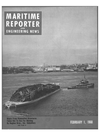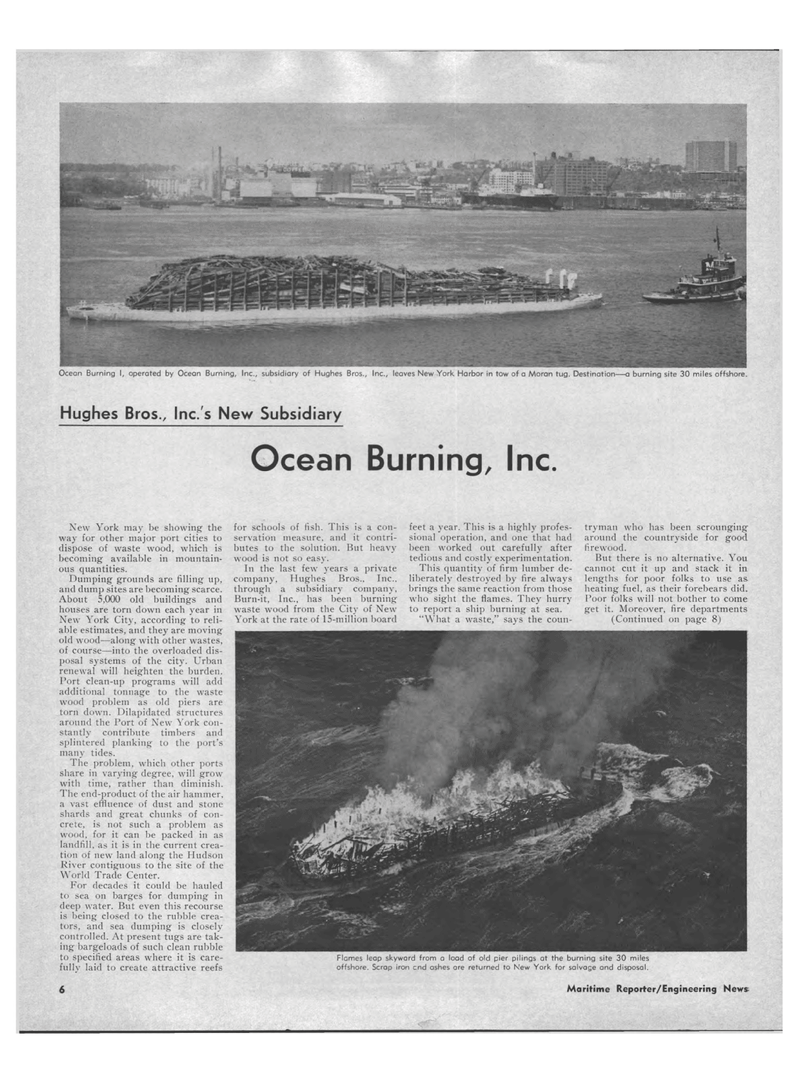
Page 4: of Maritime Reporter Magazine (February 1968)
Read this page in Pdf, Flash or Html5 edition of February 1968 Maritime Reporter Magazine
Ocean Burning I, operated by Ocean Burning, Inc., subsidiary of Hughes Bros., Inc., leaves New York Harbor in tow of a Moran tug. Destination?a burning site 30 miles offshore. Hughes Bros., Inc.'s New Subsidiary Ocean Burning, Inc. New York may be showing the way for other major port cities to dispose of waste wood, which is becoming available in mountain-ous quantities. Dumping grounds are filling up, and dump sites are becoming scarce. About 5,000 old buildings and houses are torn down each year in New York City, according to reli-able estimates, and they are moving old wood?along with other wastes, of course?into the overloaded dis-posal systems of the city. Urban renewal will heighten the burden. Port clean-up programs will add additional tonnage to the waste wood problem as old piers are torn down. Dilapidated structures around the Port of New York con-stantly contribute timbers and splintered planking to the port's many tides. The problem, which other ports share in varying degree, will grow with time, rather than diminish. The end-product of the air hammer, a vast effluence of dust and stone shards and great chunks of con-crete, is not such a problem as wood, for it can be packed in as landfill, as it is in the current crea-tion of new land along the Hudson River contiguous to the site of the World Trade Center. For decades it could be hauled to sea on barges for dumping in deep water. But even this recourse is being closed to the rubble crea-tors, and sea dumping is closely controlled. At present tugs are tak-ing bargeloads of such clean rubble to specified areas where it is care-fully laid to create attractive reefs for schools of fish. This is a con-servation measure, and it contri-butes to the solution. But heavy wood is not so easy. In the last few years a private company, Hughes Bros., Inc.. through a subsidiary company, Burn-it, Inc., has been burning waste wood from the City of New York at the rate of 15-million board feet a year. This is a highly profes-sional operation, and one that had been worked out carefully after tedious and costly experimentation. This quantity of firm lumber de-liberately destroyed by fire always brings the same reaction from those who sight the flames. They hurry to report a ship burning at sea. "What a waste," says the coun-tryman who has been scrounging around the countryside for good firewood. But there is no alternative. You cannot cut it up and stack it in lengths for poor folks to use as heating fuel, as their forebears did. Poor folks will not bother to come get it. Moreover, fire departments (Continued on page 8) Flames leap skyward from a load of old pier pilings at the burning site 30 miles offshore. Scrap iron end ashes are returned to New York for salvage and disposal. 6 Maritime Reporter/Engineering News

 3
3

 5
5
